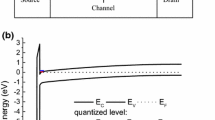Abstract
With the development of ULSI silicon technology, metal oxide semiconductor field effect transistor (MOSFET) devices are scaling down to nanometer regime. Energy of carriers in inversion layer in MOS structure is quantized and consequently, the physics and then the transport characteristics of inversion layer carriers are different from those in semi-classical theory. One essential matter is that the widely used concept of conduction band (valence band as well) effective density-of-states is no longer valid in quantized inversion layer. In this paper, an alternative concept, called surface layer effective density-of-states, is used to model the characteristics of MOS structure including threshold voltage, carrier sheet density, surface potential as well as capacitance.
Similar content being viewed by others
References
Taur, Y., Buchanan, D. A., Chen, W. et al., CMOS scaling into the nanometer regime, Proceedings of the IEEE, 1997, 85(4): 486.
Sze, S. M., Physics of Semiconductor Devices, 2nd Ed. New York: Wiley, 1981.
Stern, F., Self-consistent results for N-type Si inversion layers, Phys. Rev. B, 1972, 5(12): 4891.
Tomasz, J., Bogdan, M., Influence of carrier energy quantization on threshold voltage of metal-oxide-semiconductor transistor, J. Appl. Phys., 1994, 175(10): 5186.
Jallepalli, S., Bude, J., Shih, W. K. et al., Electron and hole quantization and their impact on deep submicron siliconp-andn-MOSFET characteristics, IEEE Trans. Electron Devices, 1997, 44(3): 297.
Ip, B., K., Brews, J. R., Quantum effects upon drain current in a biased MOSFET, IEEE Trans. Electron Devices, 1998, 45(10): 2213.
van Dort M. J. et al., Influence of high substrate doping levels on the threshold voltage and the mobility of deep-submicrometer MOSFET’s, IEEE Trans. Electron Devices, 1992, 39(4): 932.
Chindalore, C., Hareland, S. A., Jallepalli, S. et al., Experimental determination of threshold voltage shits due to quantum mechanical effects in MOS electrons and holes inversion layer, IEEE. EDL., 1997, 18(5): 206.
Tomasz, J., Bogdan, M., Analysis of the MOS transistor based on the self-consistent solution to the Schrödinger and Poisson equations and on the local mobility model, IEEE Trans. Electron Devices, 1998, 45(6): 1263.
Pacelli, A., Self-consistent solution of the Schrödinger equation in semiconductor devices by implicit iteration, IEEE Trans. Electron Devices, 1997, 44(7): 1169.
Rios, R., Narain, D. A., Huang, C. L. et al., A physical compact MOSFET model, including quantum mechanical effects, for statistical circuit design applications, IEDM95, 1995, 937.
van Dort, M. J., Woerlee, P. H., Walker, A. j., A simple model for quantization effects in heavily-doped silicon MOSFET’s at inversion conditions, Solid-state Electron., 1994, 37(3): 435.
Hareland, S. A., Manassian, M., Shin, W. K. et al., Computational efficient models for quantization effects in MOS electron and hole accumulation layers, IEEE Trans. Electron Devices, 1998, 45(7): 1487.
Lin Weidong, Jin Xiaodong, King Yachin et al., An efficient and accurate compact model for thin-oxide-MOSEFT intrinsic capacitance considering the finite charge layer thickness, IEEE Trans. Electron Devices, 1999, 46(5): 1070.
Ma Yutao, Li Zhijian, Liu Litian et al., Effective density-of-states approach to QM correction in MOS structures, Solid-state Electronics, 2000, 44(3): 401.
Ma Yutao, Liu Litian, Yu Zhiping et al., Validity and applicability of triangle potential well approximation in modeling of MOS structure inversion and accumulation layer, IEEE Trans. Electron Devices, 2000, 47(9): 1764.
Tsividis, Y. P., Operation and Modeling of the MOS Transistor, New York: McGraw-Hill Inc., 1987.
Author information
Authors and Affiliations
Corresponding author
Rights and permissions
About this article
Cite this article
Ma, Y., Li, Z. & Liu, L. New strategy of modeling inversion layer characteristics in MOS structure for ULSI applications. Sci China Ser F 44, 176–183 (2001). https://doi.org/10.1007/BF02714568
Received:
Issue Date:
DOI: https://doi.org/10.1007/BF02714568



